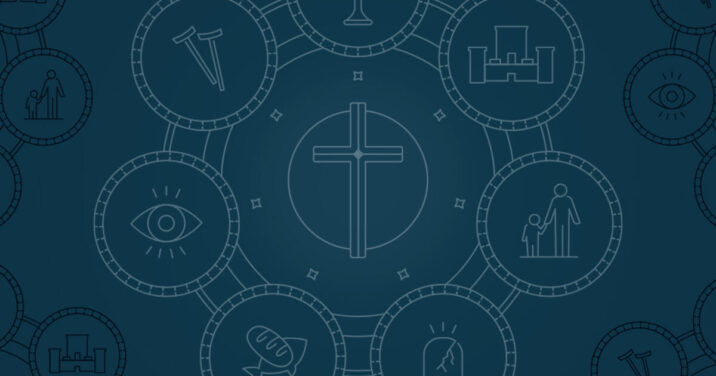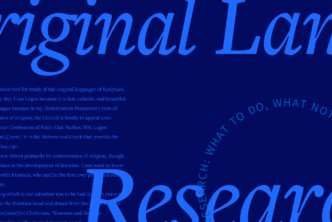It is an understatement even to say you have written much on the Gospel of John. What sets Signs of the Messiah apart?
Signs of the Messiah started out as a series of talks I gave to a group of pastors and serious Bible students over the course of a few years. In those talks, I tried to distill my key findings on John’s Gospel in order to equip pastors to preach on John’s Gospel and to provide a framework for anyone studying this wonderful and unique portion of Scripture.
Such key insights include the prominence of Jesus’s messianic signs in the first half of the Gospel—the so-called Book of Signs—as well as the overall structure of the book, organized by John in the so-called Cana and Festival Cycles, the Farewell Discourse, and the Passion Narrative, each of which is largely or even entirely unique to the New Testament Gospel literature.
My hope is that many pastors and Bible teachers will find Signs of the Messiah helpful in their spiritual growth, and that church and discipleship groups will use the book to study John’s Gospel together. I also think this is the kind of book you could give to a seeker who wants to assess for himself or herself the claims of Christ.
How long have you been studying John’s Gospel?
I’ve been studying John’s Gospel seriously for over thirty years. In the early 1990s, I wrote my doctoral dissertation on the mission theme in John’s Gospel, with a special focus on the Johannine commissioning passage, John 20:21 (“As the Father sent me, so I am sending you”).
Ever since, I’ve continued to engage in serious research on John’s Gospel, and I’ve published not only books but also specialized articles on various Johannine topics, such as John’s relationship with the Synoptics, the occasion for writing John’s Gospel, and John’s ethical teachings. Much of this detailed work has found its way, at least in digest form, into my 2009 volume, A Theology of John’s Gospel & Letters. On the whole, I’d say I spent at least a decade of concentrated research on John’s Gospel, including reading massive amounts of secondary literature.
What is it about John’s Gospel that continues to spark your interest?
The famous statement made by a previous author about John’s Gospel is that it is deep enough for an elephant to swim in and shallow enough for a child not to drown. There is a simplicity of language and yet a profundity of thought that continues to captivate me. I love Jesus, and I believe that John, the author of the Gospel, was the person closest to Jesus during his earthly ministry.
Of all the people who ever walked this earth, John knew Jesus best! Not only was he one of the twelve apostles, he was one of the three persons in Jesus’s inner circle, along with his brother James and the apostle Peter, who witnessed seminal events such as the Transfiguration and Jesus’s prayer in the Garden of Gethsemane the night before the crucifixion.
For these reasons, I cannot imagine a more authentic, credible, and definitive account of Jesus than John’s Gospel. It’s like a presidential biography written by a very close associate of the president who was with him during all the major junctures of his presidency, such as his chief of staff or another strategic member of his cabinet. So, for me, there is no better way to get to know Jesus better and to grow to love him more than to read and study John’s Gospel, which, for me, truly is the adventure and the passion of a lifetime.
Did you have any new discoveries or fresh insights while writing this book?
Building on my previous answer above, one of the things that impressed me again when writing this book is the vital importance of who wrote John’s Gospel. There are many critical scholars today who deny that the apostle John is the author, not necessarily because the evidence is against it, but because they are skeptical toward traditional church-held beliefs.
But in the case of John’s Gospel, the credibility of the entire book rests on the identity and credibility of the author. He claims to have been at Jesus’s side in the Upper Room, in the high priest’s courtyard during the Jewish trial, at the site of the crucifixion, and later at the empty tomb just after the resurrection, and finally he claims to have seen the risen Jesus himself on the shores of the Sea of Galilee.
If true, this is an incredible resume that qualifies John like no other to write an accurate and authoritative account of Jesus’s life. If not, then we can’t be so sure that the things we read about in the Gospel are really true! So, who wrote John’s Gospel matters, and it matters more than people often realize or care to admit, which is why I chose to spend a considerable amount of time exploring the internal and external evidence for the Gospel’s authorship by the apostle John in chapter 1 of Signs of the Messiah.
Do you have a favorite of Jesus’s signs?
Really, I like them all, but it’s hard not to say the raising of Lazarus. It’s such an amazing miracle, and John devotes so much space to narrating the account so very thoroughly and masterfully. You really feel like you’re part of the scene, such as when Jesus meets up with and talks with Lazarus’s sisters, Martha and Mary. Of course, in John’s presentation of Jesus’s signs, the raising of Lazaus is the seventh and climactic sign, so the strategic placement of this miracle in the Book of Signs further adds to its significance.
It’s hard not to be moved when it says in John 11:35 that “Jesus wept” (which, more accurately translated, means “Jesus burst into tears,” an ingressive aorist). But my clear favorite portion of the Lazarus narrative is the climactic verse where John writes, “The dead man came out, his hands and feet wrapped with strips of linen, and a cloth around his face” (John 11:44 NIV). A dead man walking! You don’t see that every day! And you wonder how well he could walk with his feet still wrapped with strips of linen!
What do you hope readers gain from Signs of the Messiah?
I hope they will catch my contagious love for John’s Gospel, and more importantly, my love for Jesus who is portrayed in such lofty and yet such human terms. It is truly amazing how John presents Jesus so very clearly as God, starting in verse 1 and continuing throughout his entire Gospel, all the way to Thomas’s confession of Jesus as “my Lord and my God” (20:28).
And yet, at the same time, John presents Jesus so thoroughly as human—as one who is tired and thirsty when sitting down at a Samaritan well, or, as mentioned, one who bursts into tears when mourning the death of a loved one. So, my hope is simply that readers of Signs of the Messiah get to know John’s Gospel better, and in this way get to know Jesus better, so they can love him more and serve him more devotedly and faithfully.
What is next for you? Do you have any future writing plans?
Well, thanks for asking every author’s favorite question! I am currently working on a biblical theology and after this will turn to writing the commentary on John’s Gospel for Lexham’s Evangelical Exegetical Commentary (EEC). Those are big projects, but I am at a stage in my life where I hope to leave a legacy of faithful biblical scholarship for those who come after me. In this regard, I am very grateful for my partners, and especially Lexham Press, for giving me the opportunity to publish with them. Lord willing, therefore, Signs of the Messiah is just a sneak preview of what I hope to produce in my forthcoming commentary in the next few years, so stay tuned.

***
This article was originally published in the July/August 2021 issue of Bible Study Magazine. Slight adjustments, such as title and subheadings, may be the addition of an editor.
Related articles
- An “and” That Matters: Translating and Reciting John 14:6
- Run a Referendum on John 18:6 with the Logos Passage Guide
- The Meaning of Baptism—and How It Makes the Gospel Visible
Related resources
A Theology of John’s Gospel and Letters: The Word, the Christ, the Son of God (Biblical Theology of the New Testament | BTNT)
Regular price: $39.99





